Top 10 Jira User Story Template Options for Agile Teams in 2025
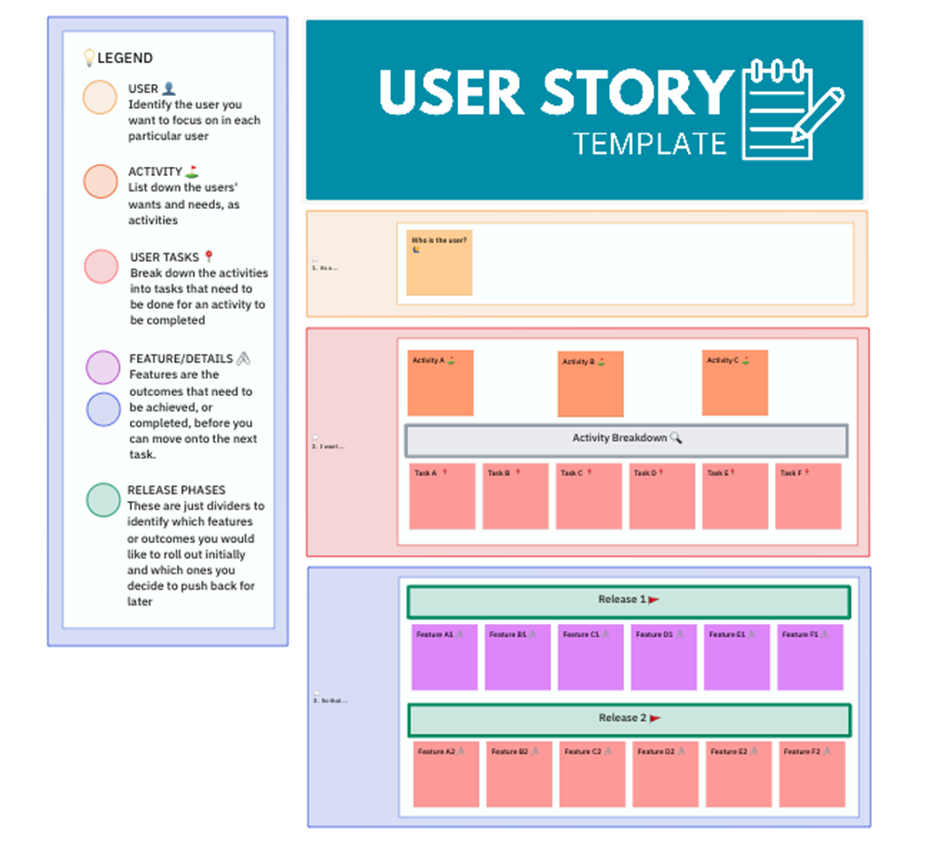
Sorry, there were no results found for “”
Sorry, there were no results found for “”
Sorry, there were no results found for “”

Jira is the go-to tool for a lot of Agile teams—but let’s be honest, it’s not always as seamless as it should be. Creating and managing user stories can take a few extra clicks (and maybe a few extra tabs), especially if you’re trying to keep things consistent across your team.
That’s where templates come in. A solid user story template can save time, reduce miscommunication, and help your team focus on what matters: building features that actually solve user problems.
In this post, we’ll walk through some of the most useful Jira user story template options (and maybe a few smarter ways to create user story templates via ClickUp).
A solid template for a user story in Jira starts with a clear format and structure for presenting your user story (e.g., As a [user], I want [goal], so that [value]). And it ends with removing roadblocks to efficient delivery.
Here are five key qualities apart from consistent formatting that make a Jira user story template fit for Agile software development teams:
Using consistent story templates improves clarity, saves time, and helps Agile teams manage Jira user stories efficiently.
👀 Fun Fact: The “INVEST” acronym guides positive user stories: Independent, Negotiable, Valuable, Estimable, Small, and Testable. Agile expert Bill Wake coined this acronym to help teams write effective stories.
Here are the best Jira user story templates to help you write clear, actionable stories that align with your team’s sprint goals.
Each template follows a user-centric format and can be copied directly into your Jira creation screen or reused via Jira story templates and issue templates if you’ve set up automation or third-party tools.
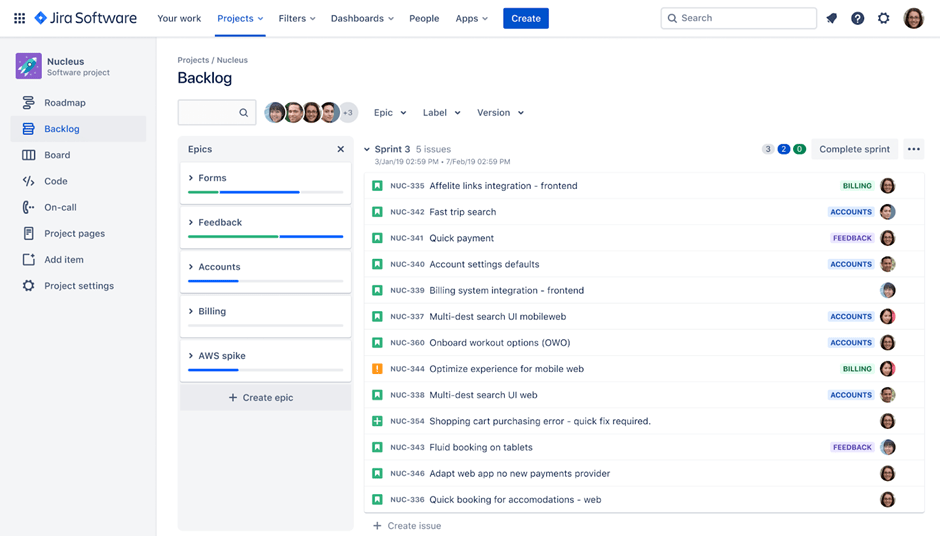
You’ve probably seen it happen: tasks keep changing mid-sprint, no one knows what the priority is, and developers are left chasing vague requirements across Slack threads and spreadsheets. Work feels reactive instead of planned, and the team ends up fixing what’s urgent, not what’s important.
The Scrum Template by Jira provides teams with a simple, repeatable method for creating Agile user stories that begin with the end user’s perspective and conclude with clearly defined acceptance criteria.
Every story is tied to a sprint, sized with story points, and visible to everyone, from the product owner to the development team. Instead of guessing what’s next, teams can focus on what’s already agreed upon—delivering value one sprint at a time, with built-in time to review, adjust, and improve.
✨ Ideal For: Agile teams who want to stop reacting and start delivering with a clear, structured sprint workflow
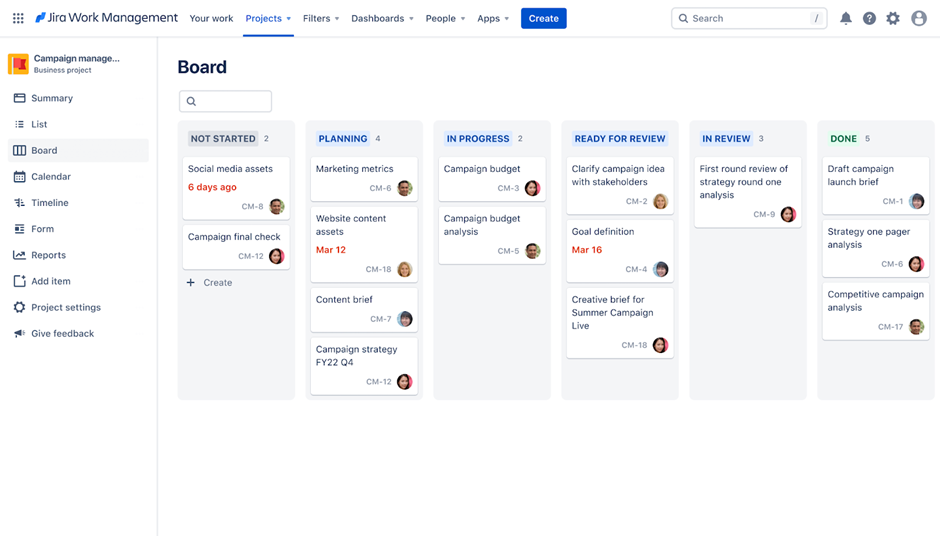
The most challenging aspect of campaign management involves the transition from planning to execution. Tasks are assigned and then reshuffled. Deadlines blur. Approvals sit in someone’s inbox while the team keeps moving without them.
The Campaign Management Template by Jira exists because Agile teams lose time trying to create templates and manage the campaign and the coordination around it.
Every task becomes a trackable item with clear owners and acceptance criteria, and every piece of progress is visible to the team. This template is how you replace crossed wires with accountability without building a new system from scratch every time.
✨ Ideal For: Marketing teams who’ve launched outstanding ideas late because execution kept getting delayed
📚 Read More: The Ultimate Guide to Scrum Project Management
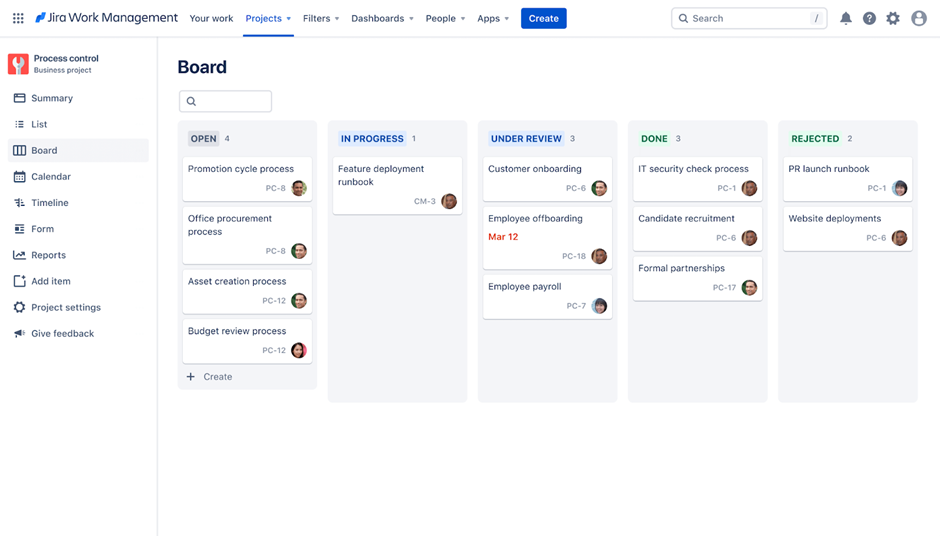
Things go wrong between “We’ve done this a hundred times” and “Why did we mess it up this time?” When processes live in people’s heads or get passed around informally, steps get skipped, context gets lost, and mistakes get repeated.
The Process Control Template by Jira fixes that by turning repeatable workflows into structured, trackable systems with Jira automations.
Every step becomes a Jira issue with a defined owner, clear acceptance criteria, and automation that keeps things moving. No more starting from scratch, and no more relying on memory or pinging the same person twice. It’s consistency, built in.
✨ Ideal For: Teams that need to run recurring processes without re-explaining them every time
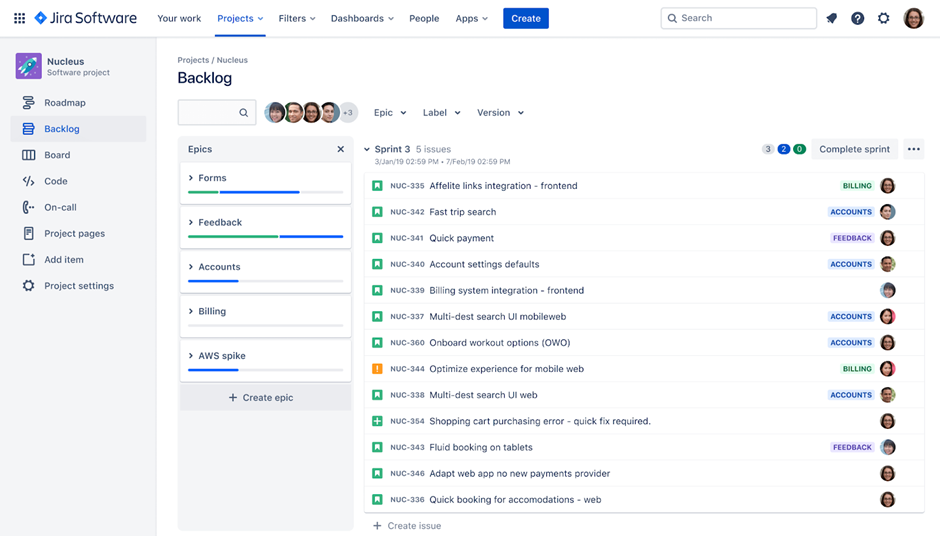
After fixing a bug, pushing a patch, and assuming deployment, a customer reports the same issue days later. It turns out that the deployment failed, and no one flagged it. Dev thought Ops had it. Ops never got the user story ticket.
This is where the DevOps Template by Jira makes a difference. It connects your development and IT workflows into a single, visible pipeline, streamlining issue creation and resolution. You can create user stories, track changes, link commits, and bake in automation rules so nothing is lost in translation.
✨ Ideal For: Software and IT teams that need better handoffs between code and deployment
📮 ClickUp Insight: ClickUp discovered that 27% of respondents face challenges with meetings that lack follow-up, resulting in lost action items, unresolved tasks, and reduced productivity. This problem is worsened by how teams track their work.
According to our team communication survey, nearly 40% of professionals manually track action items—a time-consuming and error-prone approach—while 38% use inconsistent methods that increase the chances of miscommunication and missed deadlines.
ClickUp solves this chaos by instantly turning meeting decisions into assigned tasks within the same platform where work gets done.
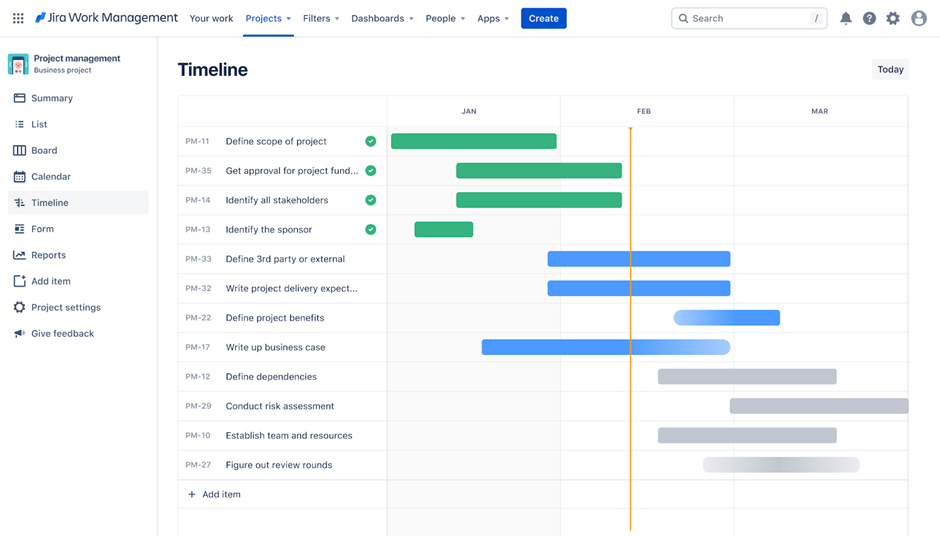
Half the effort in managing a project goes into just keeping it visible. When task updates live in five separate tools and timelines aren’t clear, teams struggle to stay aligned. Managers spend more time tracking work than moving it forward.
The Project Management Template by Jira helps prevent that. It provides a single place to plan tasks, assign responsibilities, and monitor progress across the entire project.
Here’s how it works: Each task becomes a Jira issue with deadlines, ownership, and built-in status updates, so teams can stay on top of what’s happening without extra meetings or follow-ups.
✨ Ideal For: Teams that want reliable project tracking without relying on constant, manual check-ins
📮 ClickUp Insight: According to our survey, nearly 88% of leaders still rely on manual check-ins, dashboards, or meetings to get updates.
The cost? Lost time, context-switching, and often, outdated information. The more energy you spend chasing updates, the less you have for acting on them.
ClickUp’s Autopilot Agents, available in Lists and Chats, surface status changes and critical discussion threads instantly. Here’s to never having to ask your team to send “quick updates”. 👀
💫 Real Results: Pigment improved team communication efficiency by 20% with ClickUp—keeping teams better connected and aligned.
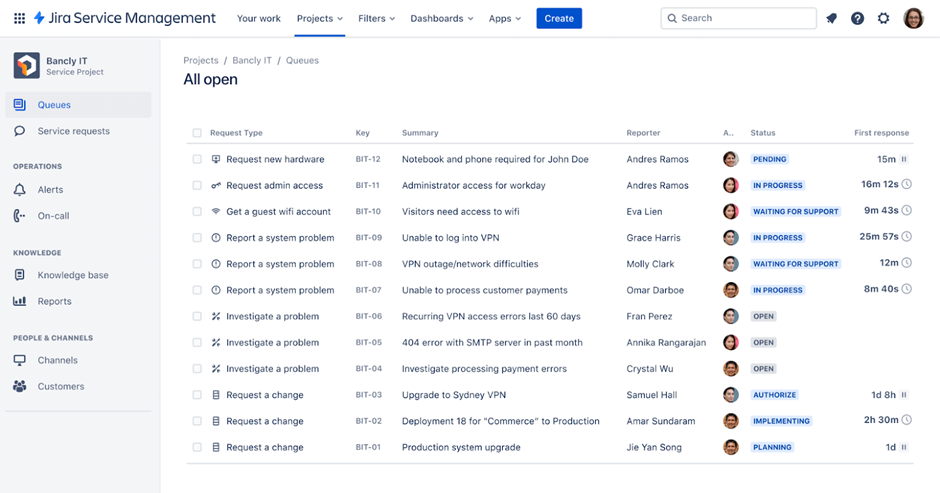
IT teams often manage requests through shared inboxes or chat threads, which makes it hard to track ownership and response times. As a result, tickets get delayed, and issues escalate before anyone takes action.
The IT Service Management Template by Jira solves this by organizing requests, incidents, and alerts in one system. This Agile template helps teams intake requests, assign them automatically, and respond faster through integrated alerts and on-call schedules.
With automation, multi-channel support, and built-in reporting, teams can manage incoming service requests and critical incidents without wasting time coordinating by email.
✨ Ideal For: IT teams that need fast, organized, and scalable ways to handle service requests and incident response
💡 Pro Tip: Managing agile epics can be tricky. Break epics into smaller user stories as soon as they’re added to the backlog—don’t wait until sprint planning. This helps your team estimate work earlier, spot dependencies faster, and avoid last-minute surprises. Use labels or Custom Fields to keep the stories grouped and traceable in a sprint management tool like ClickUp.
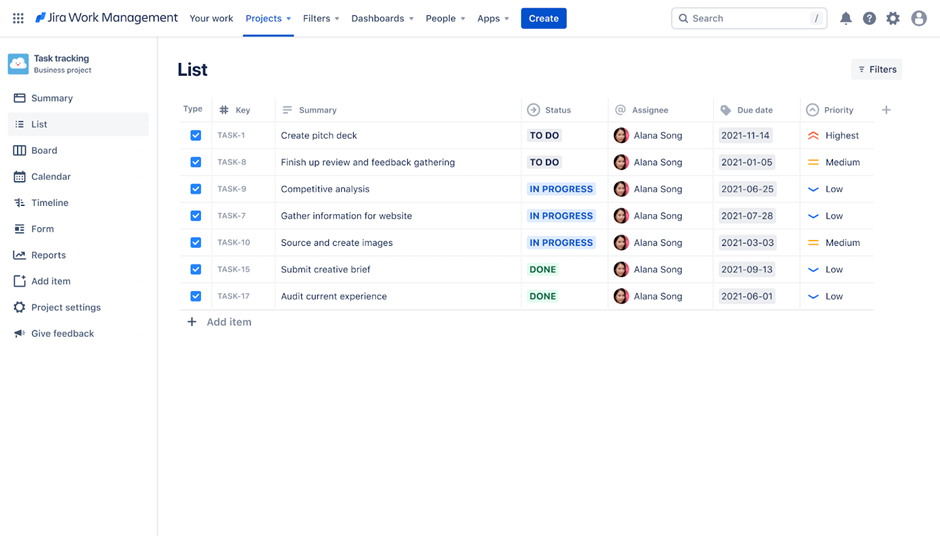
A colleague confirms completion of a task, yet it remains absent from the deck. Someone else marked it as blocked but never updated the team. Meanwhile, deadlines are getting closer, and no one has the full picture of what’s left.
Jira designed the Task Tracking Template specifically for situations such as these.
The template provides teams with a unified platform for assigning, updating, and tracking tasks. You can create Jira issues with details, deadlines, and acceptance criteria, so there’s no confusion about task status or ownership.
✨ Ideal For: Teams that struggle to stay on the same page when juggling multiple tasks across a project.
👀 Fun Fact: User stories emerged in the late 1990s as part of Agile and Extreme Programming (XP) to replace detailed specs with simple, user-focused requirements. This approach emphasized collaboration and adaptability, helping teams deliver value quickly by focusing on what users need and why.
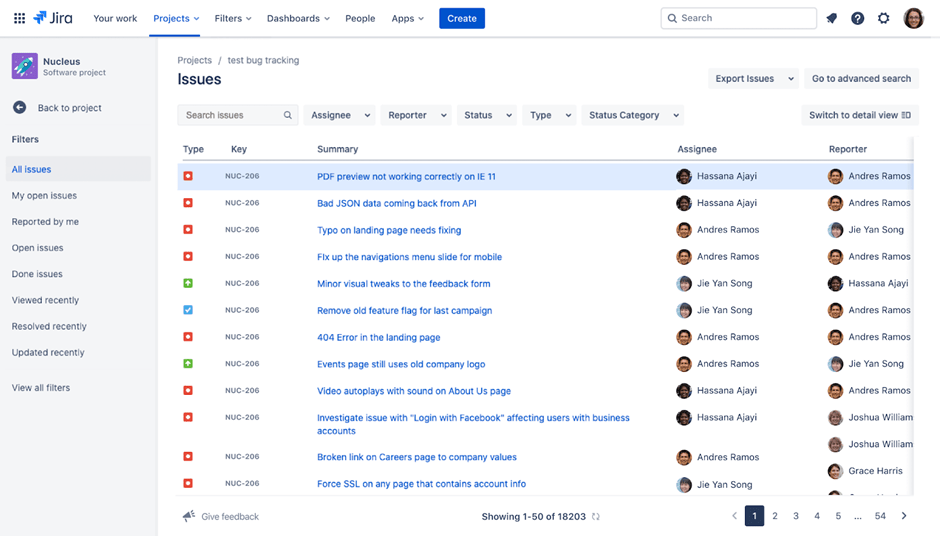
Let’s say you find a bug during testing, note it in chat, and move on. A few days later, it’s still unfixed, and now it’s affecting something else. No one logged it, no one followed up, and no one knew who owned it.
The Bug Tracking Template by Jira helps prevent these gaps. It provides your team with a structured approach to capture, prioritize, and resolve bugs through dedicated workflows.
It keeps bugs visible, traceable, and in motion, before they pile up.
✨ Ideal For: Software teams that need to track and resolve bugs without losing time to unclear handoffs
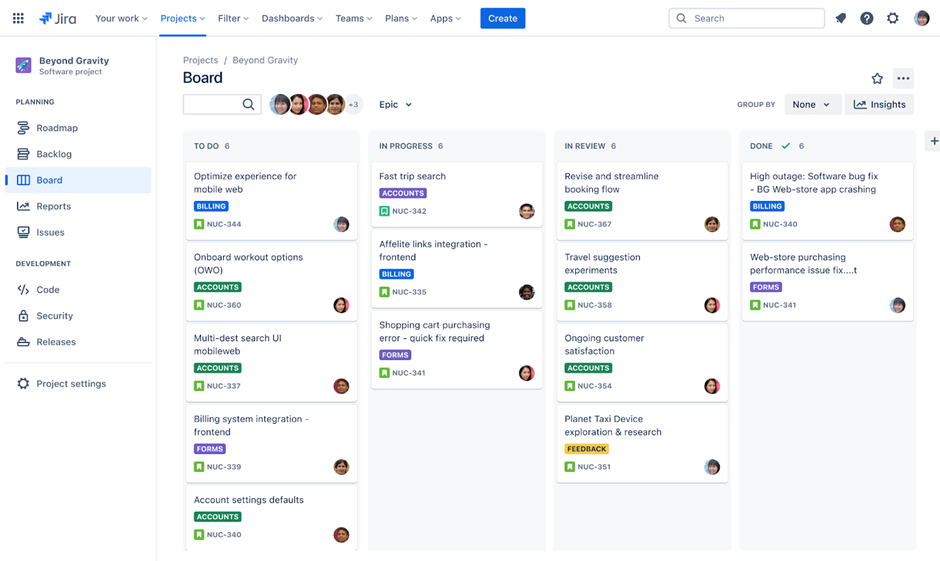
Most teams don’t realize how much time they spend just figuring out what’s going on. Someone’s task is overdue, but no one notices. A quick update turns into a 30-minute sync. Work is getting done, but there’s a visibility crisis.
The Kanban Board Template by Jira helps teams avoid that confusion. It gives you a visual system to manage tasks across different stages—like “To Do,” “In Progress,” and “Done.” Every item is a Jira issue with clear status and ownership, so there’s no guessing who’s doing what or where things are stuck.
✨ Ideal For: Teams that need visibility into daily tasks without micromanagement
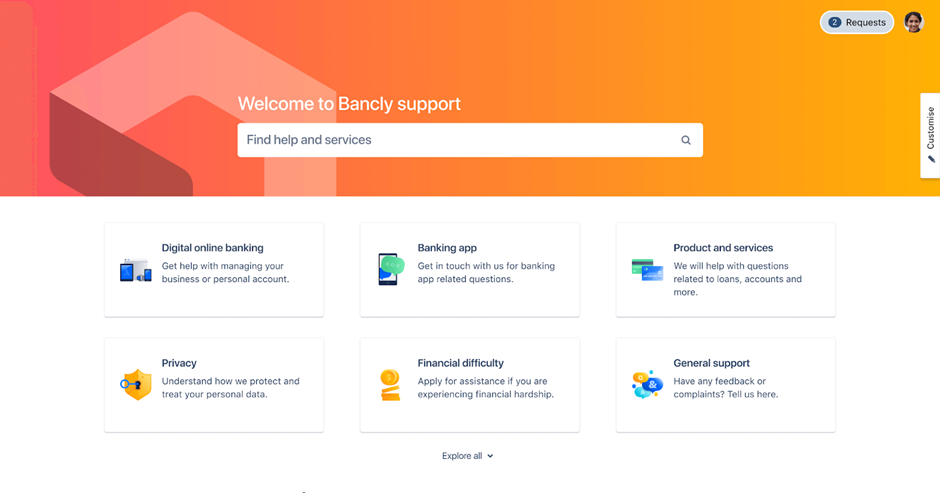
In most support teams, requests come in faster than they’re sorted. Emails, chat messages, and help tickets pile up in different places. Before long, a simple delay turns into a missed follow-up.
The Customer Service Management Template by Jira is your key to avoiding these situations.
The template helps teams set up branded portals, define clear request types, and route incoming issues to the right people. Instead of scrambling to catch up, support teams can stay organized and deliver responses that feel personal.
✨ Ideal For: Customer service teams that need a scalable way to manage external support without losing track of individual requests
Jira is powerful for tracking issues and supporting agile workflows, but it has gaps that many teams discover once they scale their usage. Here’s what you need to know before you write a good user story in Jira:
📖 Also Read: Best Jira Alternatives & Competitors for Agile Teams
ClickUp solves many of the challenges Jira leaves open. For starters, ClickUp gives teams one system to manage people, timelines, and deliverables without needing multiple integrations.
As the everything app for work, ClickUp brings your projects, documentation, and conversations together—accelerated by next-gen AI. It gives you 1000+ templates to choose from—whether you’re managing a product roadmap, planning sprints, tracking budgets, or aligning cross-functional goals.
With built-in features like the Workload view for capacity planning, Custom Fields for tracking budgets and time, and Goals for portfolio-level alignment, and ClickUp Brain for instant insights and reporting, you don’t need to stitch together multiple tools to get a complete picture of your projects.
Here are the best ClickUp templates for Agile teams, which help them plan smarter, work faster, and track everything from high-level goals to daily tasks.
A feature gets added to the sprint, but no one’s sure why it matters or how success will be measured. Developers work on it anyway, and the result doesn’t match what the user actually needs.
The ClickUp User Story Template helps avoid this exact scenario. It offers user story descriptions, a defined structure complete with the end user’s perspective, the desired outcome, and most importantly, acceptance criteria for smaller user stories.
These criteria tell the development team exactly what has to happen for the story to be considered complete, reducing rework and back-and-forth during testing.
✨ Ideal For: Agile teams who want fewer delivery mismatches and clearer definitions of “done.”
User stories often end up in spreadsheets, whiteboards, Slack threads, or scattered docs because different teams write and store them in whatever tool they use day to day. For example, a designer jots one down during a workshop. A PM logs another in a slide deck. None of them are wrong, but now the actual user story resides in four places, and no one is sure which version is current.
This forces teams to spend time syncing on things that should already be aligned.
The ClickUp Basic User Story Task Template solves that by giving everyone one place to write, store, and work on user stories in a consistent and organized manner.
Each story is written in the same format, stored in the same place, and linked to tasks, subtasks, and sprint boards. You can tag user needs, assign story points, and add acceptance criteria.
✨ Ideal For: Teams that want a single, consistent format for managing and writing user stories
Since switching to ClickUp, Savitree Cheaisang, Assistant Vice President at Bubblely, says:
“My company is much more organized and able to control the timeline on each project, tracking all activities that happen in there. I love the calculate function that gives you a quick review of numbers instead export them in excel and doing a manual calculation.”
Teams often build features in the right order technically…but in the wrong order for the user.
The result: a product that works on paper but feels incomplete in real use. This usually happens when user stories are planned in isolation, without seeing the full user journey.
The ClickUp Story Mapping Template helps teams address this by laying out user stories based on how users actually interact with the product. You can group tasks by journey step, organize them into sprints, and prioritize based on what delivers the most value first. It turns planning into a visual map, not just a list.
Speaking of visual maps, here’s a great starter video on how to create a process map in a few simple steps on ClickUp:
✨ Ideal For: Agile teams who need to map user journeys and plan development around real user behavior
📖 Also Read: What Are Agile Values
Scrum teams often spend too much time managing the process itself. We’re discussing the need to chase down updates, adjust boards mid-sprint, or hold extra meetings to understand what’s blocking progress.
The ClickUp Agile Scrum Management Template gives teams a clear system to plan sprints, manage user stories, and track velocity in real time to help them move fast.
The template includes sprint dashboards, backlog views, and burndown charts, allowing you to focus on delivering value instead of fixing the workflow.
✨ Ideal For: Scrum teams that want to manage sprints efficiently without getting bogged down in manual updates
📖 Also Read: The Ultimate Guide to the 5 Key Scrum
Agile is not limited to software teams, yet non-development teams often encounter difficulties when attempting to implement it.
Here’s why: requests come in through email, work is tracked across docs and boards, and ceremonies like retros become checkboxes instead of real improvement loops.
The ClickUp Agile Project Management Template helps teams apply Agile project management in a structured way, even outside of engineering. Forms convert requests into backlog items automatically. Boards and sprints help teams execute and adjust plans based on progress. Plus, retrospectives, reviews, and planning sessions stay tied to actual work.
✨ Ideal For: Non-dev teams using Agile tools to manage priorities, track work, and improve continuously
It’s the day before a sprint starts. Everyone is still finalizing tasks, overlooking a few dependencies, and is uncertain about the team’s actual capacity. Standups turn into planning meetings, and the sprint feels rushed before it even begins.
Stressed yet?
The ClickUp Agile Sprint Planning Template is built to fix that. It helps teams map out sprint goals, break down user stories, and define task ownership. And guess what? This is all done before the sprint begins.
With timeline views and dependency mapping, it’s easier to spot risks early and balance the team’s workload realistically.
✨ Ideal For: Agile teams that want to reduce last-minute planning and run sprints with clarity and control
Most of the time, marketing teams do everything right: tight briefs, strong ideas, and fast execution. But even high-performing teams can get tripped up by miscommunication. For example, a campaign can get delayed because the designer didn’t know the brief had changed. It’s frustrating to see that much effort go in the wrong direction.
The ClickUp Agile Marketing Template is built for this kind of environment.
You can break campaigns into tasks, plan sprints, assign ownership, and track changes in real time. It’s built to adapt, so when plans shift, you don’t lose time starting over.
✨ Ideal For: Marketing teams that need a flexible, organized way to plan and execute campaigns at speed
📖 Also Read: How to Calculate Story Points in Agile
Over half of IT professionals use Agile consistently to manage each software feature, while many others blend Agile with other approaches.
Yet, despite widespread adoption, teams often struggle to keep their backlogs organized and aligned with product goals.
The ClickUp Agile Story Template addresses this issue by standardizing how user stories are written, ordered, and executed.
Next, stories are organized in order of priority, tied to sprint goals, and linked to larger product objectives. Teams can track progress using burndown charts, update story status in real time, and keep both day-to-day tasks and long-term planning in sync.
✨ Ideal For: Product and dev teams that want a structured, high-clarity backlog that leads to real progress
👀 Fun Fact: The daily standup meeting originally lasted exactly 15 minutes—just enough time to keep updates quick and efficient.
Teams often overlook the larger picture when they excessively concentrate on individual tasks. Without a clear plan, sprints can drift off schedule, dependencies get missed, and communication breaks down.
The ClickUp Agile Roadmap Template helps teams stay aligned by providing a visual timeline of goals, sprints, and dependencies all in one place. It makes it easy to estimate effort, track progress, and adjust plans as priorities shift.
This template gives teams the clarity and structure they need to meet deadlines and avoid surprises.
✨ Ideal For: Agile teams that need a clear overview of their project timeline and dependencies
Many teams think Agile sprint events, including planning, standups, and reviews, are just time-consuming meetings that slow progress. The truth is, when organized well, these ceremonies allow teams to identify blockers early.
The ClickUp Agile Sprints Events Template structures all sprint events in one place, making it easy to plan, track, and collaborate efficiently. It helps teams avoid wasted time and makes every sprint event count toward delivering results.
✨ Ideal For: Agile teams managing multiple projects who want to streamline sprint ceremonies and boost collaboration
📖 Also Read: How to Implement Sprint Planning in Excel
Rework is an efficiency killer. User story templates capture conversations that allow teams to write better stories faster, align around shared goals, and deliver real value with less confusion. All of this leads to fewer reworks.
While Jira is a powerful tool widely used for managing Agile workflows, the lack of built-in automation slows things down.
This is where ClickUp steps in as a clear leader. With automation features, ClickUp saves an estimated one hour per day for every employee and drives a 12% increase in work efficiency.
Empower your team to work smarter by signing up for ClickUp now!
© 2026 ClickUp